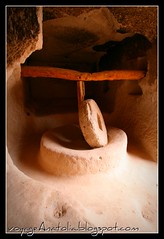
 Wheat was a key factor enabling the emergence of city-based societies at the start of civilization because it was one of the first crops that could be easily cultivated on a large scale, and had the additional advantage of yielding a harvest that provides long-term storage of food.
Wheat was a key factor enabling the emergence of city-based societies at the start of civilization because it was one of the first crops that could be easily cultivated on a large scale, and had the additional advantage of yielding a harvest that provides long-term storage of food. "I saw seven lean cows which rose out of the river and devoured seven fat cows! and, I saw seven withered ears of grain which devoured seven fat ears!"The archaeological record suggests that
this first occurred in the regions known as the Fertile Crescent, and the Nile Delta. These include southeastern parts of Turkey, Syria, the Levant, Israel, and Egypt. Recent findings narrow the first domestication of wheat down to a small region of southeastern Turkey, Göbekli Tepe and Karacadag which has been dated to 9,000 B.C., that is the Neolithic period. However evidence for the exploitation of wild barley has been dated to 23,000 B.C. Some say this is also true of pre-domesticated wheat.

Map of Neolithic Revolution: Origins of agriculture and spread in prehistory. [wikipedia] .